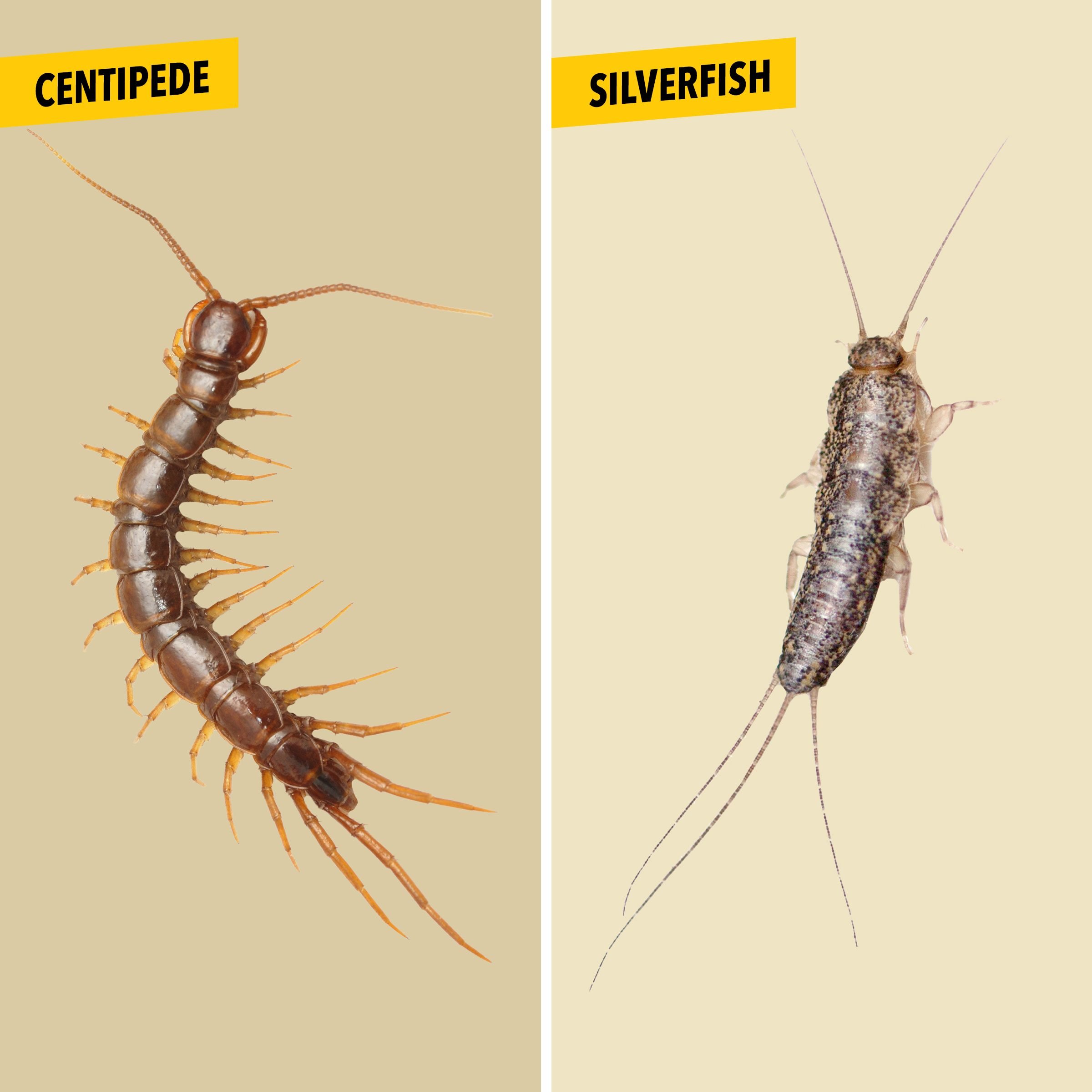Not many things can push your freak out button faster than stepping from the shower and spying a centipede or silverfish scurrying across your bathroom floor. They’re creepy with all those legs and long antennae, and learning what attracts them can make you feel like a lousy homeowner.
While the sight of either insect can be unnerving, one is bigger and actually benefits your home. The other is a pest you should get rid of. Here’s what you need to know.
House Centipede vs. Silverfish: What Do They Look Like?
House centipede
Bodies are around 1-1/2-in. long, yellow-brown and striped, with large antennae. While there seem to be 100 legs (hence the name), most have 32. Discover the most common types of centipedes you’ll find in your house.
Silverfish
Silverfish are shorter than house centipedes, around 1/2-in. inch long, but with similar large antennae. They’re also flatter, with a dark gray to silver body, and only six legs.
House Centipede vs. Silverfish: Where Do They Live?
House centipede
An estimated 8,000 centipede species exist worldwide, some in tropical rainforests, deserts and even the Arctic Circle. The largest, a 12-inch centipede from South America, eats mice and lizards. House centipedes like dark areas with high humidity, including attics, closets, crawl spaces and basements.
Silverfish
Silverfish can be found in Africa, the Americas, Australia, Eurasia and parts of the Pacific. They seek moist areas with 75% to 95% humidity. In urban areas, they like attics, basements, bathtubs, sinks, kitchens, old books, classrooms and showers.
House Centipede vs. Silverfish: Behavior
House centipede
Centipedes can move at 1.3 feet per second. According to the Columbus Dispatch newspaper, “House centipedes don’t walk or run as much as they glide, sort of like a spooky undulating feather magically levitating across the wall.”
Centipedes are carnivorous and eat other small insects, cockroaches and certain spiders. An increase in centipedes means an outbreak of other pests in or around the home.
They generally avoid humans. When provoked, some large centipedes may bite, causing localized swelling, discoloration and numbness. If you don’t bother them, they won’t bother you. They kill insect pests, including silverfish.
Silverfish
Silverfish can jump up to two feet and sometimes outrun centipedes and spiders. They don’t bite humans, but their presence may indicate cracks in your foundation. Subsequent water damage may lead to mold, mildew, fungi and algae. Silverfish are also known to hitch rides in cardboard boxes of books.
Silverfish can be destructive eaters, often ruining papers, clothing and wallpaper. They’re nocturnal, feeding on cellulose, shampoos, glue in books, linen, silk and dead insects. They can go weeks without food or water but generally stay close to a food source.
House Centipede vs. Silverfish: How To Get Rid of Them
House centipede
Recently I saw a centipede scurry across my kitchen floor. I didn’t want to sour my day with a kill and clean up, so I picked it up with a tissue and threw it outside. I did the right thing, according to Ike Osakuni, with Abra Kadabra Environmental Services in Mound, Minnesota.
“Centipedes are not harmful,” Osakuni says. “[They] eat pests like silverfish, box elder bugs and cockroaches, and are territorial and eat each other. So you won’t get a lot of them in your house.
“People call about centipedes and are emotional. You can’t blame them, but centipedes look worse than they are. If you want to get rid of them, put sticky traps along your baseboards.”
A bifenthrin or cypermethrin spray kills centipedes. But since they’re beneficial, why bother? You’re better off leaving centipedes alone.
Silverfish
Silverfish are attracted to dust and paper. To get rid them, Osakuni says, get rid of moisture and messes.
I do a decent job cleaning the kitchen after meals, keeping dry foods in closed containers, fixing holes in the house and keeping a lid on my garbage — all good. However, silverfish require high humidity to survive, and I don’t use a dehumidifier — not good.
If you’ve got silverfish on your walls, spray with a mixture of two parts water and one part bleach. Pour bleach and hot water down drains to kill any silverfish lurking in pipes.
I don’t spread salt, which attracts and dehydrates silverfish. I don’t spread boric acid, which kills silverfish, or use the smell of citrus, cinnamon and lavender, which silverfish hate.
Silverfish Packs, Ultrasonic Silverfish Repellant and such are available, but I’ll probably keep it simple and call Osakuni. He uses a non-poisonous spray outside and throughout the inside of the house to keep silverfish away.
ⓘ




















